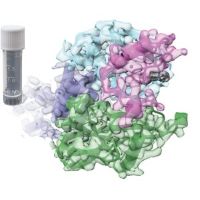Specification
| Target | GST |
| Conjugate | HRP |
| Application | |
| Conjugate | HRP |
| Host | |
| Isotype | VHH domain of alpaca IgG2b/2c |
| Reactivity | GST |
| Purificatin | Affinity Purification |
| Concentration | |
| Buffer | 10mM PBS (pH 7.5), 0.05% sucrose, 0.1% trehalose, 0.01% proclin300 |
| Storage | For long-term storage, keep at -20°C. Avoid repeated freeze/thaw cycles. |
| Advantages | · High affinity · Lot to lot consistency · Short Incubation |
Background
| Background | VHH or Nanobody is the next generation monoclonal antibody, which is a Single domain antibody (sdAb) reserving only one single antigen recognizing domain from camelid heavy chain antibody. With size of only ~ 15 kDa, Nanobody dispay numerous advantages over conventional antibody and it's derivatives, such as higher tissue penetration capability, more accessible to hidden epitopes, higher stability(thermal and pH resistant), solubility (aggregation avoidance) and binding affinity. The glutathione S-transferase (GST) tag is a common affinity tag used for protein purification and detection. This ~26 kDa protein, when fused to a protein of interest, allows for easy purification using glutathione-coated beads. The strong interaction between GST and glutathione enables efficient capture and subsequent elution of the fusion protein. GST can also be used for protein detection via anti-GST antibodies. Anti-GST Nanobody Beads are magnetic agarose beads covalently coupled with VHH antibodies/ nanobodies acquiring high specificity and affinity for target protein. These nanobeads can efficiently capture and separate target tagged proteins from cell crudes or other samples. |
QC Data
| Note | Please contact us for QC Data |
| Product Image (Reference Only) |  |

